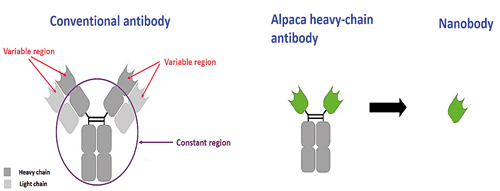Would the adorable alpacas help our fight against COVID-19?

Alpacas at the Max Planck Institute for Biophysical Chemistry in Göttingen, Germany Source: https://www.mpibpc.mpg.de/animal_facility
The Alpaca is a member of the camel family, Camelidae, and is reputed as a gentle, quiet and friendly animal. The relationship between humans and alpacas goes back to thousands of years. It is believed that the people of the Andes Mountains in South America domesticated the wild relatives of these animals 6000-7000 years ago, to be used for transportation and fleece production.
Both alpacas and their other domesticated cousins, IIamas are commonly used in medical research. The presence of small and unique antibodies in them has drawn the special attention of virologists. Antibodies are protective proteins produced by the immune system in response to the presence of a foreign substance like pathogenic bacteria or viruses. Antibodies attack and neutralise the foreign invaders (known as antigens) thereby making them no longer infectious.
The antibody molecule consists of four polypeptide chains; two identical heavy chains and two identical light chains, arranged to a “Y” shaped structure. There are constant and variable regions within particular classes of antibodies. The tips of the arms of “Y” contain a variable region called “antigen-binding site”. The pathogenic bacteria or viruses get bound to this site of the antibody molecule.
In addition to conventional antibodies, alpacas, llamas and other members of the camel family possess “heavy-chain only” antibodies. This specific antibody molecule comprises only two heavy chains and lacks the two light chains found in conventional antibodies. The antigen-binding region of a heavy-chain antibody is called VHH or nanobody.
Nanobodies are inherited with unique properties such as nanoscale size, robust structure, stable and soluble behaviours in aqueous solution, high affinity and specificity for their target antigens. Moreover, the longer VHH domains would facilitate their reach to targets inaccessible to conventional antibodies. Thus, over the recent years, nanobodies have increased their attractiveness as potential drugs and their production at an industrial scale is found to be less expensive and less complex than conventional antibody manufacturing.

The conventional antibody, alpaca heavy-chain antibody and nanobody
During the last few months, several research groups have produced llama or alpaca nanobodies against the SARS-CoV-2 spike protein. As spike protein plays a crucial role in the entry of the virus into a host cell, those nanobodies were believed to be effective at preventing infections of COVID-19.
Very recently, scientists at the Max Planck Institute for Biophysical Chemistry in Göttingen and the University Medical Center Göttingen, Germany were able to develop highly potent therapeutic nanobodiesfrom alpacas. But what’s so special about these newly developed nanobodies? One of the key features is their ability to bind up to 1000 times more strongly to the spike protein than the previously reported nanobodies. Moreover, these new nanobodies are effective against the major Coronavirus variants; Alpha, Beta, Gamma, and Delta. Also, they are found to be suitable for inhalation and thereby for the direct virus neutralization in the respiratory tract. Due to their very small size, they can penetrate tissues easily and prevent further spreading of the virus.
The new nanobodies are heat-resistant, hence capable of withstanding temperatures of up to 95 °C without losing function. So they might remain active in the body for a long period providing a longer-lasting therapeutic effect.
In addition to the simplest “single nanobodies”, two other forms of nanobodies; “nanobody triads” and nanobody tandems” are also available. “Nanobody triads” are designed by bundling three identical nanobodies. These“nanobody triads” can neutralize the virus even up to 30,000-fold better than the single nanobodies. On the other hand, “nanobody tandems” prepared by combining two nanobodies are extremely resistant to virus mutations. A feature common to all three forms is the requirement of a very small amount to stop the pathogen. That means a lower dosage is sufficient if used as a drug. Another advantage is that these nanobodies can be produced at low costs and in large quantities.
At the moment these alpaca-derived nanobodies are in preparation for clinical trials. The success of these trials will bring hope for the patients caught up with COVID-19 and those who cannot build up an effective immunity. So, while adhering to all the safety precautions to prevent infection and to slow transmission of COVID-19, let’s keep our fingers crossed !
(The writer is attached to the Faculty of Medicine,
University of Ruhuna)


